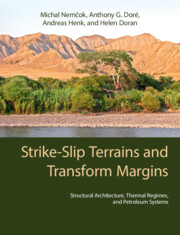Many of the world’s continents are bounded, or traversed, by vast fault networks that move laterally, like the well-known San Andreas Fault. These strike-slip regimes are vitally important to the world’s natural resources – petroleum, water, and geothermal energy. This book covers all aspects of transform and strike-slip regimes: how they initiate, how they develop, and the natural resources associated with them. Numerous global case studies are utilized to illustrate structural development, thermal and fluid flow implications, and commercial applicability. The work aims to be useful to a broad range of readers, from students of geology and researchers specializing in strike-slip regimes to geoscientists and managers involved in the business of natural resources and energy solutions.
The concept for the book originated with the projects “Petroleum systems of sheared margins” and “Thermal history of transform margins,” researched during 2014–2020. Building on earlier regional transform margin projects focused on the Guyana–Suriname Basin, West Australian transform margins, the Coromandal transform of East India, and Equatorial Atlantic transform margins, these two projects examined exploration in strike-slip and transform margin settings, using the large literature base and original research, addressing gaps in knowledge. A key objective of the research was to highlight the differences between transform and extensional rift margins. The combined research on transform margins indicates that exploration practices developed for rifted margins have limitations when applied to transform margins.
This follow-on synthesis brings considerable additional data into the picture, including results of long-term research focused on strike-slip terrains and transform margins, and includes a more extensive database documenting structural styles, thermal regimes, petroleum systems, and rates of geologic processes.
The volume utilizes examples of strike-slip terrains with large databases gathered over decades of research including the Los Angeles and San Joaquin Basins of the San Andreas Transform Fault System, the Central Sumatran Basin associated with the Sumatran Fault, and the Drava, Sava, and Vienna Basins associated with the boundary faults of the ALCAPA terrane in the Carpathians. Classical petroleum provinces of the Los Angeles and San Joaquin Basins in California and Vienna Basin in the Carpathian hinterland indicate that these basins can host several coexisting petroleum systems. In addition, medium- and high-temperature geothermal fields and prospects occur in these strike-slip provinces. Eleven fields in the Salton Sea region are hosted by high-temperature geothermal systems, as well as the Coso field and Medicine Lake prospect further north.
Research into transform margin settings generally lags behind research on rifted margins. However, some transform settings, such as the St. Paul, Romanche, Davie, Guayana, Northern Demerara, and Agulhas–Falkland transform margins, are currently undergoing extensive investigation and developing large databases, all of which are included in this volume.
While the oceanic basins of a transform used to be viewed by hydrocarbon exploration as outboard of the area of interest, current transform margin research brings multiple results indicating the contrary. For example, the South American side of the Romanche and Guyana transform margins borders several distinct ridges and troughs at the oceanic fracture zones, developed during the time when both transforms were in their oceanic–continental development stage. It is becoming evident that these intersections may create unique effects on sediment routing, possible source rock development, heat flow, and migration pathways.
In this book we employ a three-part approach – first addressing the fundamental controls, architecture, and fluid flow characteristics of strike-slip regimes, then moving on to the implications for thermal regimes, and finally considering applicability to petroleum systems.
The first block synthesizes the structural, depositional, erosional, and fluid flow knowledge necessary to understand strike-slip and transform margin settings. It begins with basic descriptions of structural styles and tectonic transport, understanding of which is necessary for the proper layout of geophysical surveys. It includes determination of crust types, which are necessary for definition of different petroleum system candidates; considers structural segmentation, which defines the size and geometry of a potential petroleum system; and addresses structural timing, which is necessary for understanding source/reservoir/trap/seal temporal relations. This block also reviews the kinematics and dynamics of strike-slip faults, the evolution of transforms through the continental, oceanic–continental, and transform margin stages, and the controlling role of lithospheric composition. The block concludes by describing occurrences, mechanisms, rates, and controlling factors of associated fluid flow systems and magmatism.
The second block develops the thermal foundation for geothermal and petroleum system analysis. It evaluates critical factors influencing the thermal history of rocks in strike-slip and transform margin settings, including the effects of pre-rift heat flow regime, lithostratigraphy, deposition, structural framework, erosion, and deformation. It concludes with a description of key elements necessary for an efficient geothermal fluid flow system. It does this by characterizing play concept elements of geothermal fields and prospects worldwide.
The third block investigates implications of the strike-slip and transform margin setting for associated petroleum systems. It systematically describes source rock distribution, maturation and generation history, reservoir distribution, seal distribution, potential migration scenarios, trap types, and preservation issues. Again, a large array of global examples is presented to illustrate these concepts.

